Yves here. Putin volunteered in a recent interview that it was odd that Raisi took his fatal trip in an old American helicopter, which due to sanctions would be difficult to maintain, while the other two helicopters that made the same trip were fairly new, well-kitted out, Russian made birds.
By John Helmer, the longest continuously serving foreign correspondent in Russia, and the only western journalist to direct his own bureau independent of single national or commercial ties. Helmer has also been a professor of political science, and an advisor to government heads in Greece, the United States, and Asia. He is the first and only member of a US presidential administration (Jimmy Carter) to establish himself in Russia. Originally published at Dances with Bears
It was a frustrated Sherlock Holmes who told Dr Watson: “You will not apply my precept,” he said, shaking his head. “How often have I said to you that when you have eliminated the impossible, whatever remains, however improbable, must be the truth?”
That was in 1890 in the Arthur Conan Doyle story, “The Sign of Four”.
Application of this Holmes rule of detection and deduction to the circumstances of the crash of Iranian President Ebrahim Raisi’s helicopter on May 19 is now producing the inescapable conclusion that Raisi, Iranian Foreign Minister Hossein Amir-Abdollahian, and the six others on board their aircraft were killed by the actions of one or both of the pilots, who intended their own suicide and the killing of their passengers.
This appears not to have been the conclusion of the Iranian Air Force commanders who paid a condolence visit to the families of the pilots on May 21, two days after their deaths.
But with the release last week by the Iranian Army’s General Staff of its second report on the fatal crash, the elimination of weather, machine failure, external missile attack, on-board bomb, electronic sabotage, and pilot navigational error is now complete. Together with the first General Staff report, the detailed Teheran television interview of Raisi’s chief of staff, Gholam-Hossein Esmaeili, and the eyewitness testimony by telephone from the crash scene by the Tabriz ayatollah, Mohammad Ali Al-Hashem, the evidence remaining is that the highly experienced chief pilot, Colonel Seyed Taher Mostafavi (lead image, right) made three mistakes — the first, to fly into the cloud bank after he ordered the others to climb above; the second, not to detect on his radar and other instruments the sharp mountain peaks in close proximity to his flight course at 2,200 metres; and the third, to crash in horizontal orientation, not vertically nose first.
Hattricks are rare, but they are never mistakes, never accidental.
To catch up on the forensic details as they were initially confirmed for the fatal incident, read this piece of May 27.
For a summary of the contradictory media reporting from Iranian military and other local sources, assembled by an anti-regime source in London, click to read. Israeli fabrication and disinformation on the incident is of decidedly lower quality than the Iranian propaganda; click to compare.
OVERVIEW OF THE HELICOPTER CONVOY ROUTE
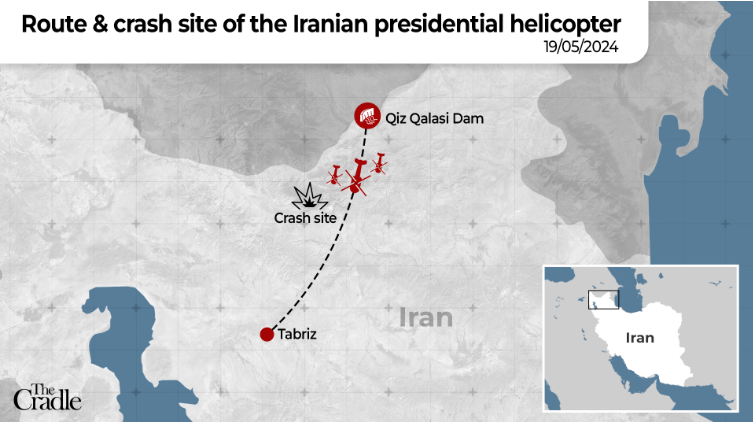
Source: https://thecradle.co/
SATELLITE VIEW OF THE CLOUD COVER OF THE ROUTE AND CRASH SITE
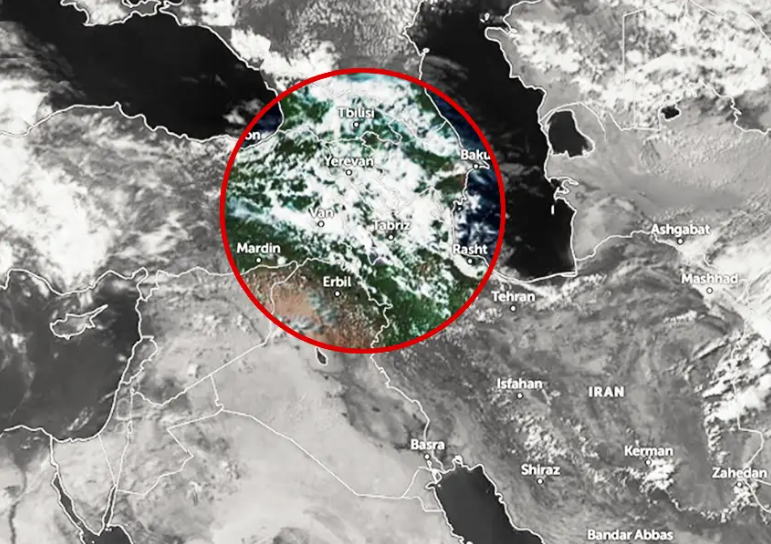
Source: https://www.iranintl.com
Iran International, an anti-regime medium based in London and Washington, financed by Saudis, concluded its coverage on May 23 with an account of contradictory media reports. This piece reached no conclusions, and so far it has not been updated.
In the state news agency report, published late on May 29, the Army investigators concluded “based on sampling and tests conducted on the wreckage and parts of the helicopter, as well as the distribution pattern of the debris from the main body, the occurrence of an explosion caused by sabotage during the flight and moments before the impact with the mountainside is ruled out, the report said. Additionally, investigators carefully examined the vast majority of the documents related to the maintenance of the helicopter and found no issue that could have played a role in the accident, it added.”
“The report also revealed that the helicopter’s capacity in terms of the maximum standard load it could carry at the point of take-off and throughout the flight path and the return route was found to have been within the ‘permissible limit.’ The recorded conversations between the flight crew show that the last contact with the pilots up to the time of the incident and when they stopped responding lasted 69 seconds, and no emergency declaration was recorded during that time, it added.”
“The military investigators also ruled out any disruption in the communication system or frequency interference with the helicopter. They revealed that during the flight and up to 69 seconds before the crash, contact with the aircraft had been maintained on the specified frequencies. The report further said that there were no signs of any cyberattack carried out against the presidential helicopter.”
What is missing from the second Army report is the radar and black-box records of whether in the last 69 seconds there was a bearing or course change by Mostafavi at the controls of the president’s aircraft. In the Army’s first report, it was claimed “the helicopter has already continued on the predicted path and has not departed from the designated flight path.”
A western military aviation expert refers to the training manual for the Bell 212 model of helicopter in which Raisi was travelling. This source says that the technical data the Army will have checked but have yet to reveal, include:
— altitude of the convoy when Mostafavi gave the order to climb above the clouds
— speed of the aircraft at that time
— course and bearing of the front and rear aircraft
— record of course deviation by the Raisi aircraft in the final 69 seconds
— altimeter specifications in the Bell-212 helicopter
— technical factors explaining why Raisi’s aircraft did not gain altitude after Mostafavi gave the climb order to the convoy.
From the geographical coordinates published for the crash site, the altitude at which the crash occurred has been estimated at 2,200 metres.
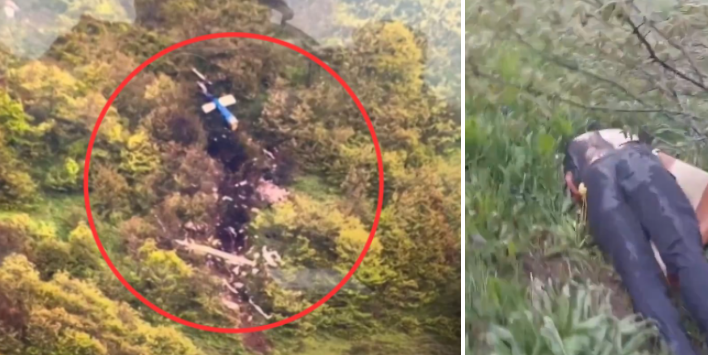
Left, drone image above the crash site. Right, video from rescuer at ground level which appears to show the body of Al-Hashem clear of the crash debris.
This is how the eyewitness in the third helicopter, behind Raisi’s aircraft, described the altitude, cloud and weather conditions: “Esmaeili:..There was fog on the ground, but not in up the air where we were advancing with the helicopters. However, in one small compacted area, there was a small patch of clouds above a cliff. In terms of height, this cloud was at the same height as our flight’s height. It was there that the now-martyred helicopter pilot [Mostafavi], who was also the commander of the fleet, told the rest of the pilots to ascend above the clouds. We were third behind the president’s helicopter. We rose above the clouds and advanced for approximately 30 seconds. Our pilot suddenly realized that the main helicopter carrying the president was missing.”
Esmaeili said the pilot of his aircraft estimated that 90 seconds had elapsed between the radio contact of Mostafavi giving the order to climb above the cloud bank and the “disappearance”. “…we also have no radio contact with it anymore. So I asked him when was the last time contact was made? The pilot answered, ‘A minute and 30 seconds ago when the pilot [Mostafavi] told us to ascend above the clouds.’”
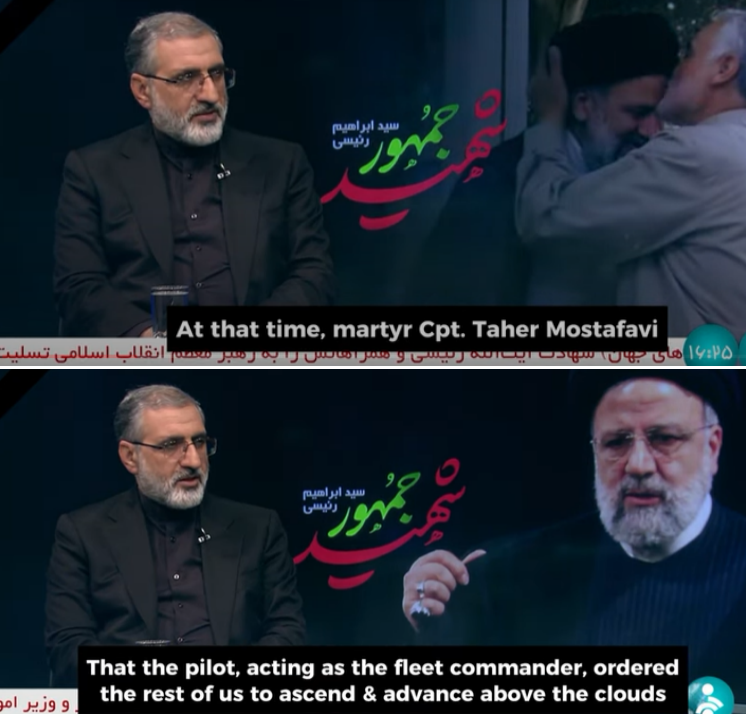
Esmaeili is explicit. It had been Mostafavi who had been at the controls of Raisi’s aircraft and who gave the order to the others to climb above the cloud.
Esmaeili also revealed the direct testimony of Al-Hashem, who was thrown clear of the helicopter fuselage at the crash and was not reached by the fire which consumed the other passengers in the cabin. “After some tries, calling the cellphone of the captain [Mostafavi] accompanying the president, someone picked up the phone. It was Ayatollah Hashem, the Friday Imam of Tabriz. He told us that he was not feeling well. He didn’t tell us anything special. I asked him what exactly had happened. He told us that he didn’t know what had happened, and when asked about his whereabouts, he said that he didn’t know. He only described what he could see, described to us what he saw, for example, how he was surrounded by trees. I asked him about the condition of the others, the Ayatollah replied that he’s alone and couldn’t see anyone else and he’s alone.”
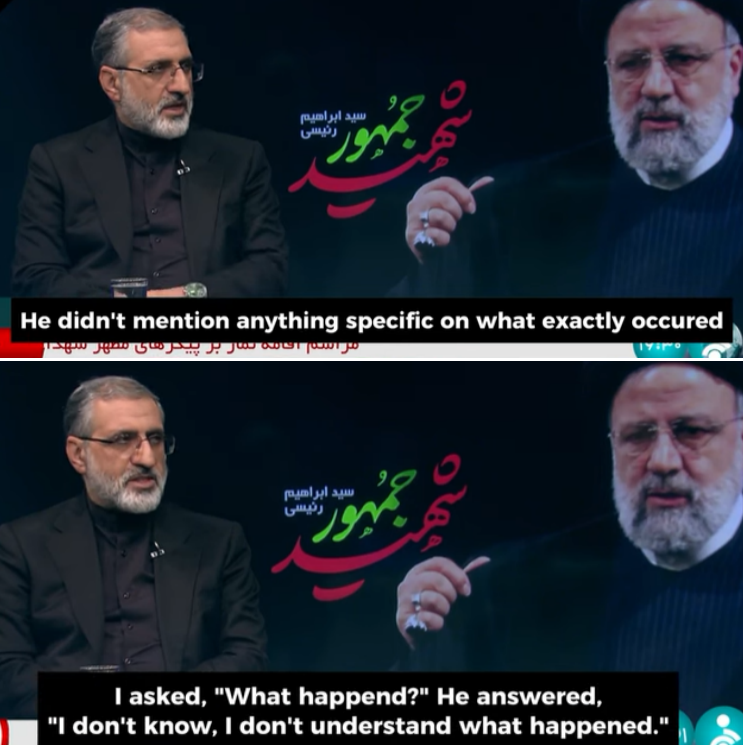
In Esmaeili’s account, he and others were able to speak to Al-Hashem over a three-to-four hour period. The telephone which Al-Hashem answered was Mostafavi’s, according to Esmaeili.
The western aviation source comments: “We can be certain that there was no noticeable or alarming acceleration due to increasing throttle, a dive, or both. We have Al-Hashem’s last communications verifying this, as well as 90 seconds of no radio traffic which in an emergency of this kind typically includes cries for help or other chatter identifying a struggle in the cockpit. This makes me wonder if the crew had made a pact.”
“We assume the [Bell] 212 was cruising at 190kph. The final communication with the pilot was 90 seconds before the crash. The math tells me that in those 90 seconds the 212 flew 4,769m horizontally. We don’t know the altitude of the group before the order to climb was given, but we do know the service ceiling of the 212 is 5300m, so there was plenty of capacity to get above the 2200m height of the mountain where the aircraft ended up.”
“The 212 is equipped with a radio altimeter. This equipment generally stops giving height indications at 2500ft/ 762m. We have no evidence [from Al-Hashem] that the altimeter sounded off or that any of the flight crew or passengers heard it before the crash. The altimeter could have been disabled. By the looks of the crash site, the 212 didn’t hit a sheer cliff or steep mountainside, so we can expect that the altimeter would have sounded before collision if it had been working and/or been monitored.”
“Now, the key thing is that the pilot ordered the other two helicopters to climb, while he did not. He flew into the clouds. Did he descend, or just fly into the mountain at 190kph? Did he know that on his current course the altimeter, if it was working, would not sound due to the slope of the terrain until it was too late to change course? The Army says there was no course change during the flight, but did the pilot, instead of descending into the clouds, change course while maintaining altitude after entering the cloud cover, thus hitting the mountain. This would explain the calmness of all on board.”
“The pilot knew exactly what he was doing.”
Suspicion of pilot suicide in an assassination plot has not been reported in the Iranian domestic media, in the two Army reports, or in the Iranian opposition media outside the country. Nor has it surfaced in the Russian military blogs.
There appears to have been no suspicion of the two pilots, Mostafavi and Colonel Mohsen Daryanosh, in the first days after the incident when their families and homes were visited by Brigadier General Hamid Vahedi, the Iranian Air Force commander, and Brigadier General Massoud Jafari, commander of Shahid Lashgari Air Base.
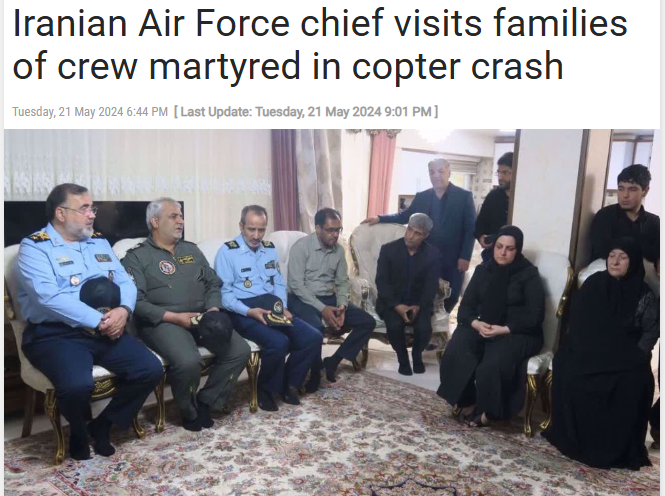
Source: https://www.presstv.ir/
How and why Mostafavi gave his personal telephone to Ayatollah Al-Hashem before the flight began is an unanswered question. In the circumstances now, so too is the question of what evidence Mostafavi left on his telephone, if any.


